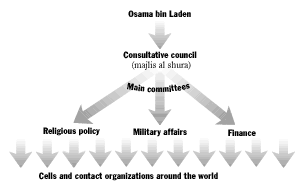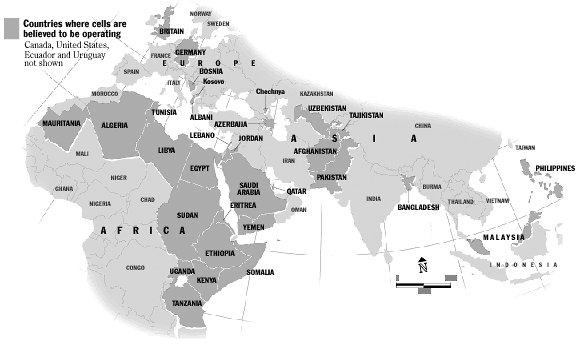|
Bin
Laden's long reach
Since the early 1990s, Saudi exile Osama bin Laden has built a
secretive, highly compartmentalized but interlocking terrorist
network with the purpose of ousting pro-Western governments in the
Middle East, derailing the Arab-Israeli peace process and driving
the United States from the region. In early 1998, the militant
multimillionaire issued a call to Muslims ordering holy war against
Western interests.
Funding
| · |
Bin Laden, 44, the son of a Saudi construction magnate,
has estimated assets of $300 million. The United States has
frozen some of his accounts. |
| · |
While living in Sudan from 1991 to 1996, bin Laden set up
money-making businesses in construction, trucking, currency
exchange and various exports. The umbrella group is Taba
Investments. |
| · |
Cells around the world engage in semi-clandestine fund
raising. |
Strength
| · |
The organization may have several hundred to several
thousand members. It draws from a pool of more than
50,000 Afghan war veterans and other radical Muslims. Bin
Laden spent the 1980s mostly in Peshawar, Pakistan, where he
supported Afghan mujaheddin who were fighting to oust Soviet
troops. |
Terrorist operations
| · |
Al-Qaida runs military training camps in Afghanistan and
possibly elsewhere. The United States bombed several
suspected training camps in 1998. |
| · |
Among the group's suspected bombing targets, before the
air attacks on New York and Washington, were:
1993: World Trade Center; six dead, more than
1,000 wounded.
1996: U.S. military housing complex in Dhahran, Saudi
Arabia; 19 servicemen killed, 372 wounded.
1998: U.S. embassies in Kenya and Tanzania; 224
killed, 5,000 hurt.
2000: USS Cole in Yemeni harbor of Aden; 17 sailors
killed, 39 wounded.
|
 Structure Structure
Western intelligence officials believe that the organization, al
Qaeda (the base), has a hierarchical structure. Bin Laden, who for
security reasons moves constantly around Afghanistan, mostly in the
Kandahar region, heads the organization.
How a cell structure works
| · |
Secrecy and security are essential and cells are usually
small. For terrorist actions, al-Qaida cells apparently are
split into planning and execution phases. |
| · |
Members of one cell do not necessarily know members of
another. |
| · |
Communications between cells are usually made secretively,
sometimes by use of dead drops. |
| · |
Cells may remain inactive for years, or engage only in
fund raising or peaceful Islamic activities. A cell may
suddenly be called into action. |
| · |
Sympathizers are recruited to perform low-level logistical
tasks. |

Al-Qaida cells are believed to exist in at least 35 countries or
regions, but they shift constantly. Some are known to have ties to
Islamic extremist groups that the U.S. State Department has
designated as foreign terrorist organizations.
Sources: Jane's Intelligence Review, Congressional
Research Service staff reports
 |
| THE
WASHINGTON POST |
|